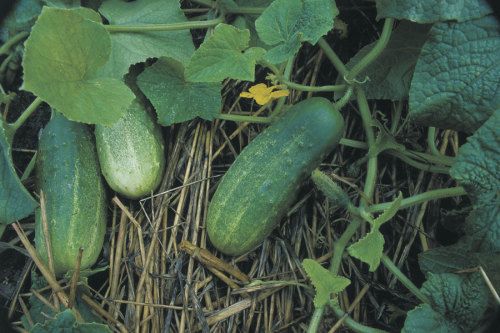
by Cass Peterson
June 1999
from issue #21
My Aunt Eleanor was a great one for pickles. She maintained a large patch of pickling cucumbers, which it was often my duty to pick. The patch was a sea of cucumber vines into which I went barefoot, feeling with my toes for the fruit hidden amid a tangle of stems and leaves, every misstep filling the air with the scent of crushed cucumber.
A 10-minute treasure hunt was usually enough to fill a two-gallon bucket, and I took my reward in a couple of fresh cucumbers—one to eat and one to cut open and rub on legs itching from the plants’ spiny foliage. Cucumbers are soothing, inside and out.
Aunt Eleanor had the space to indulge her love of pickles, but you can enjoy the crunchy goodness of just-picked cucumbers without surrendering the entire garden to their rampant vines. Hybridizers have been busy making cucumber plants more compact, as well as more productive and more resistant to disease. Picklers are prolific and quick to produce, with some varieties bearing in as little as 45 days.
Picklers for crunch and eye appeal
The first picklers were selections from the original cucumbers, and all of them were rangy of vine and stingy of fruit, like the fearsome and prickly West Indian gherkin. But even back in the mid-19th century, when New England horticulturist Fearing Burr was cataloguing them, picklers had been tamed to vine lengths of 10 feet or so. Modern varieties are a third to a half shorter and have more flowers along the vine as well.
You don’t have to pickle picklers. Harvested young, when the seed cavities are small, any variety of pickler is fine for fresh eating—in a salad or out of hand. Pickler varieties aren’t uniformly dark green like the slicing-type cucumbers sold in the supermarket. They are paler green, sometimes with light-colored stripes running lengthwise down the fruit. Picklers have thinner skin and crisper, crunchier flesh than most slicers. A few plants will be enough to keep you in fresh cukes.
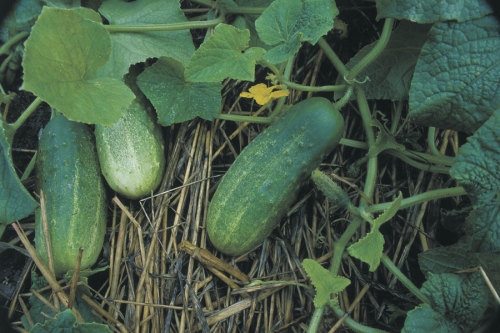 |
| The dark green skin of ‘Calypso’ helps set it apart from many other picklers, which typically have light-colored stripes or speckles. |
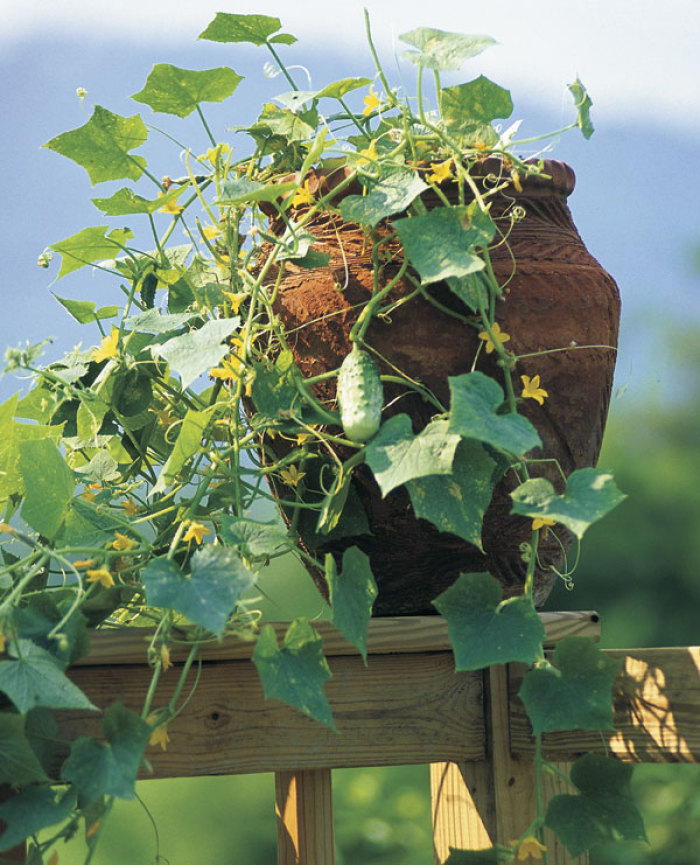 |
|
| Dwarf cucumbers can be grown in containers. |
Catalog descriptions of vining habits aren’t always useful. The word “vigorous” is often used to indicate heavy flowering and fruiting, rather than rampant vines. You won’t really know their habit until you try them, but in general, the newer hybrids, which means picklers as well as standard cucumbers, tend to have shorter vines. In my garden, ‘Calypso’, ‘Royal’, and ‘H-19 Little Leaf’, relatively new introductions in the pickler category, will travel 4 to 6 feet, but you can turn the vines back on themselves if they stray too far. ‘Pickalot’ and ‘National Pickling’, venerable varieties, will journey a good 8 to 10 feet from where they’re planted, but they, too, can be trained to climb over themselves.
There are dwarf varieties—including ‘Bush Pickle Hybrid’, which has vines just 18 inches long—that are suitable for growing in small spaces or even in containers. Cucumber vines are attractive enough that a pot of them wouldn’t look out of place on the patio. ‘H-19 Little Leaf’ is a particularly good candidate, with its ivylike foliage and clouds of yellow flowers.
Cucumbers have grasping tendrils and willingly haul themselves up a fence or trellis. If you have limited space but want to grow one of the standard-size pickling hybrids like ‘Calypso’ or ‘Royal’, consider growing them vertically.
|
The history behind bitter cucumbers Cucumbers originated in India, where they have been cultivated for more than 3,000 years. Wild ancestors of the fruit, however, were part of the human diet long before that. Excavations on the Burma-Thailand border found cucumber seeds among the remains of meals eaten around 9750 b.c.e. Pickling was invented early, too, possibly because the ancients discovered that soaking cucumbers in brine took the bitter edge off the flavor of the fruit. At the time of the pharaohs, Egyptians ate brine-dipped cucumbers at every meal. Those early cucumbers were probably more closely related to the West Indian gherkin (Cucumis anguria) than to the juicier, sweeter cucumber (C. sativus) that modern gardeners plant. Nutritionally, cucumbers aren’t much to write home about. The fruit is 96 percent water and contains only a small amount of vitamins A and C, with most of that found in the peel. That’s why one of my favorites is ‘Calypso’. Because it’s dark green, whereas many picklers are paler, it fools me into thinking I’m getting nutrition where I’m not. The water content gives cucumbers their cool reputation Unless, of course, the gardener happens to grab a bitter cuke. Cucumbers produce natural compounds called cucurbitacins, which are responsible for the bitterness that sometimes develops in the skin. Cucurbitacins at high levels can cause stomach distress, and in any case they give the cucumber a strongly bitter flavor. Heat and water stress can increase cucurbitacin levels to the point where the cucumber must be peeled to be palatable. Roughly one in five people can’t taste cucurbitacins, and so have never eaten a bitter cucumber. But twice that many people are hypersensitive to the bitter taste, which is why plant breeders have been working to reduce the level of the compounds that cucumbers produce. The result is so-called burpless cucumbers, bred to produce fewer cucurbitacins. |
How to deal with a pesky pest
The cucumber beetle, 1⁄5 inch long, either spotted or striped, is the worst enemy of cucumbers, especially in the Midwest and East. It is attracted to the scent of cucurbitacins, which are produced by cucumbers, squashes, melons, and other cucurbits.
Adult beetles feed on flowers and foliage; their larvae feed on roots. Worse, the beetles may infect the plant with a disease called bacterial wilt, which blocks the flow of water through the plant’s stems. Cucumbers are especially susceptible to bacterial wilt, for which there is no remedy. Infected plants will wilt and die within days.
A few cucumber beetles in the patch isn’t a guarantee of bacterial wilt. The beetle must first pick up the disease bacterium, usually from weeds that may not show symptoms of the disease. But the risk of wilt is always there if the cucumber beetle is present.
Young plants are the most susceptible to striped cucumber beetle damage. Once a plant has developed at least three pairs of true leaves, it can tolerate considerable damage to its foliage without reducing yield. You can protect young plants from cucumber beetles with a polyester row cover, but eventually it must be removed to let bees and other insects pollinate the flowers.
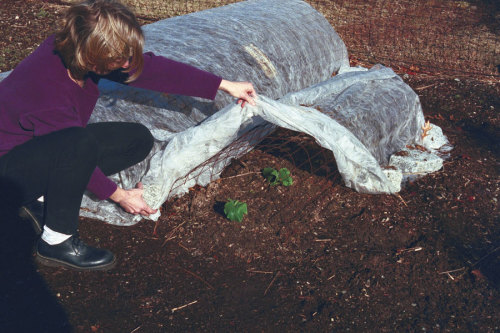 |
| A layer of light row cover helps protect young cucumber plants from the rapacious cucumber beetle, but it must be removed for pollination. |
My defense against beetles and bacterial wilt is to plant cucumbers several times a year. If the plants are protected until they need pollination, chances are they will produce a decent crop before the wilt strikes, if it strikes at all. Planting successive crops a few weeks apart assures me of fresh cucumbers all season long, even if the beetles do in one or more of the plantings. (For more on managing these pests, see Controlling Cucumber Beetles).
|
Cucurbitacin lures Cucurbitacins, the bitter chemical compounds found in cucumbers and other members of the squash family, pose complex issues for plant breeders and those trying to fend off pests. They are irresistible to cucumber beetles, which home in on the cucurbitacin scent to find the plants they love to eat. In tests, cucurbitacins laced with insecticide have been used to lure cucumber beetles to their doom. It’s a bit like being done in by a craving for chocolate. Although the cucurbitacin compounds attract cucumber beetles, they also act as a natural pesticide, repelling or killing many other insects. Burpless cucumber varieties produce fewer of the cucurbitacins people don’t want to taste, but tend to attract more insect pests, such as aphids and spider mites. On the other hand, burpless varieties may be less susceptible to damage from the cucumber beetle. Meanwhile cucurbitacin lures are part of the growing field of Integrated Pest Management. Although some kinks remain, such as how best to deliver the compound, what has worked in research may one day be the salvation of home garden cukes, too. |
Cucumber fertility
To be sure I get the most from each planting, I like to plant gynodioecious varieties like ‘Calypso’ and ‘Royal’. Cucumbers are naturally monoecious, which means that they have male and female flowers on the same plant. Gynodioecious varieties produce only female flowers, which makes them capable of producing nearly twice the number of fruits as monoecious varieties, because only female flowers produce fruit.
Cucumber types Monoecious: producing male and female flowers on the same plantGynodioecious: producing only female flowersParthenocarpic: requiring no pollination and producing seedless fruit |
|
You will need a few male flowers to provide pollen. Seed companies take care of this by including in the packet a few seeds of a monoecious variety, which are usually dyed a vivid color so you can be sure to plant a few along with your gynodioecious cucumbers.
There’s another class of cucumbers: parthenocarpic varieties, which require no pollination and produce seedless fruit. Most of the available parthenocarpic cucumbers are slicers, but a new cornichon pickler variety called ‘Cool Breeze’ is both parthenocarpic and burpless.
Parthenocarpic cucumbers are a bit trickier to grow than gynodioecious varieties because they must be carefully protected from chance pollination by other cucumbers or by wild relatives. But they can be left covered to exclude cucumber beetles right up until harvest time, a boon for beetle-plagued areas.
Seed catalogs generally describe pickling cucumber varieties as either white-spined or dark-spined, referring to the color of the prickly spines, which rub off easily. It really doesn’t make any difference which you get. White-spined varieties will ripen white, and dark-spined will ripen yellow, but at that stage the cucumber is over the hill anyway.
Sources for pickling cucumbers Seeds for pickling cucumbers are available from: • Burpee • Gurney’s Seed & Nursery Co. • Harris Seeds • Johnny’s Selected Seeds • Fedco Seeds |
|
Cucumbers want warm, tender soil
Cucumbers are warm-weather plants, and will sprout readily if sown directly into warm soil. You can gain a little time on the season by starting the plants indoors, but be forewarned that cucumbers, like all cucurbits, resent having their roots disturbed. If you choose to use seedlings rather than seeds, start them in peat pots no sooner than three weeks before you intend to plant them outdoors and transplant carefully to avoid root damage.
Sow two or three seeds together, in the ground or in a peat pot, and let the young plants grow up together. No need to thin them out.
Cucumbers like a light, fertile soil. If your garden has heavy clay soil, lighten it up with compost or peat before attempting cucumbers. Good compost also will provide the steady supply of nutrients that cucumbers need. If you use commercial, granulated fertilizer, mix a generous handful into the soil at planting and sidedress at least once during the season.
Adequate moisture is critical
Cucumbers need a deep soaking once a week, at a minimum. Mulching is a good idea, too. It will help prevent the soil from drying out between waterings, and it will keep weeds down. This is important for cucumbers, because pulling weeds by hand or cultivating with a hoe might damage those sensitive roots.
Start harvesting pickler cucumbers when they are 2 to 3 inches long, and don’t let the fruit grow to more than 4 or 5 inches long. Picklers tend to flabbiness in the middle when allowed to get too big. None is particularly long-lived in the fridge. They respire through their skins and get wrinkly, hence the supermarket cuke with its protective coat of wax or shrink-wrap. A week or so is top storage time.
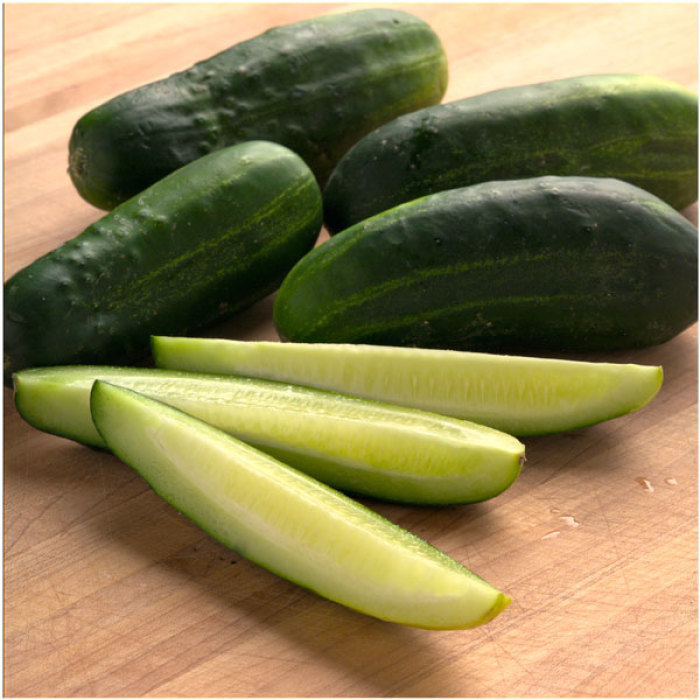 |
|
| Pickling cucumbers, with their tight seed cavities and firm flesh, make for terrific eating straight out of the garden or chilled in a salad. |
As Aunt Eleanor knew well, frequent picking will keep the plant productive longer. You may even do this barefoot.
When cooking with cucumbers, extract the water first the kitchen
When using pickler cucumbers in recipes such as Cucumber and Noodle Salad with Satay Dressing, Mediterranean Cucumber Salad, and Cucumber and Yogurt Raita, you will want to extract some of the water so the dishes don’t turn out soggy. So peel the cucumbers, cut them into the shape you need, salt them, and place them in a colander. Let them drain for about a half hour and pat them dry—if they’re grated, squeeze gently first. Then proceed with the recipe. This makes the cucumber dishes saltier, so don’t add salt until you’ve tasted.

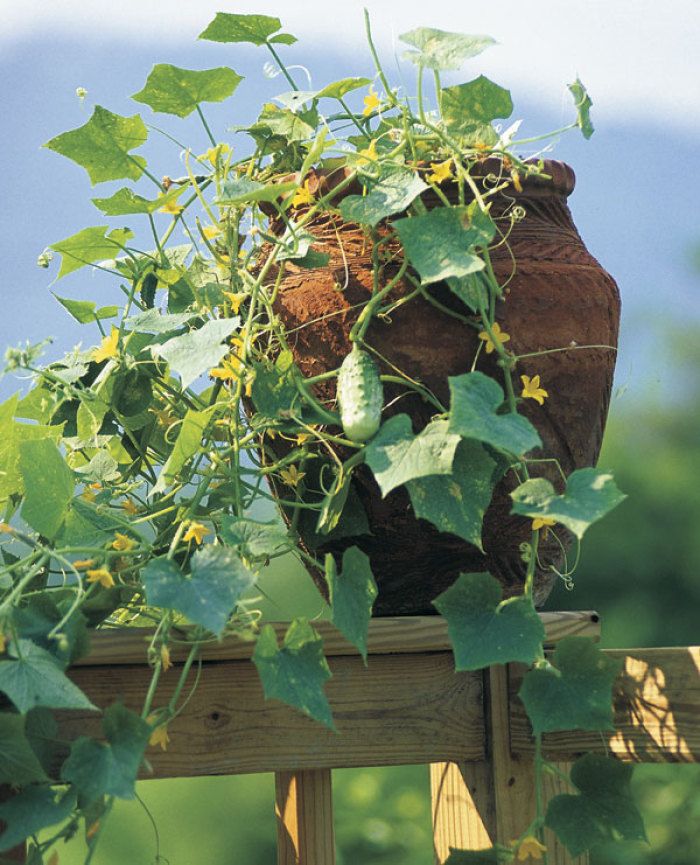
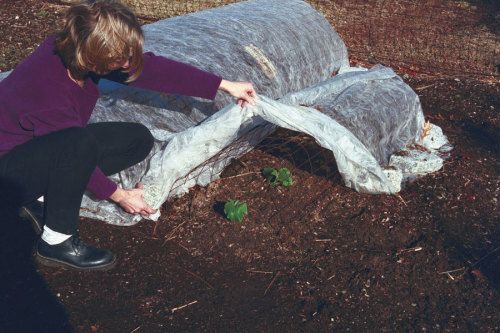
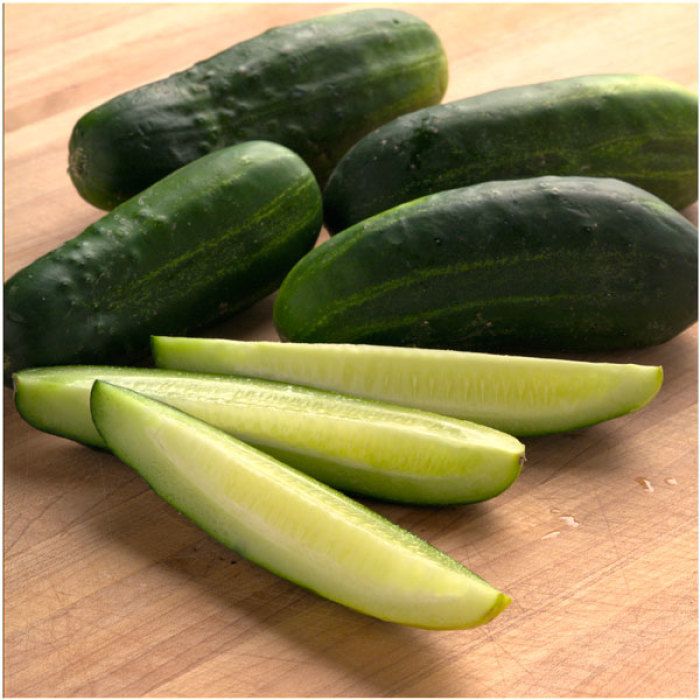
















Comments
Log in or create an account to post a comment.
Sign up Log in